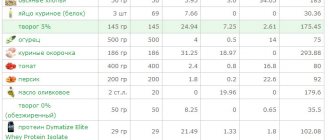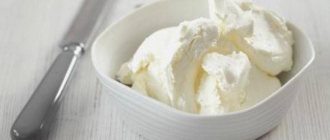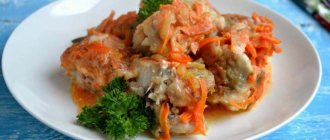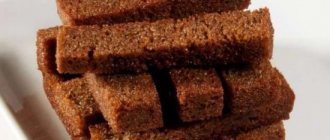A storehouse of vitamins
Broccoli is a very valuable product that can be put on a par with eggs and cottage cheese, since this cabbage contains a whole complex of vitamins and minerals. Here are just a few of them: potassium, iron, calcium, manganese, sodium, phosphorus, methionine, thiamine, riboflavin, as well as vitamins A, C, B, E, PP.
If you made a long list of all the beneficial substances that make up broccoli, it might look something like this:
- Vitamin PP (Niacin equivalent), (PP) - 1.1071 mg;
- Vitamin K (phylloquinone), (K) - 101.6 mcg;
- Vitamin E (TE), (E (TE) - 0.78 mg;
- Vitamin C, (C) - 89.2 mg;
- Vitamin B9 (folic acid), (B9) - 63 mcg;
- Vitamin B6 (pyridoxine), (B6) - 0.175 mg;
- Vitamin B5 (pantothenic acid), (B5) - 0.573 mg;
- Vitamin B2 (riboflavin), (B2) - 0.117 mg;
- Vitamin B1 (thiamine), (B1) - 0.071 mg;
- Vitamin A (RE), (A (RE) - 386 mcg;
- Vitamin PP, (PP) - 0.639 mg;
- Vitamin A, (A) - 0.386 mg;
- Phosphorus, (P) - 66 mg;
- Potassium, (K) - 316 mg;
- Sodium, (Na) - 33 mg;
- Magnesium, (Mg) - 21 mg;
- Calcium, (Ca) - 47 mg.
As you can see, broccoli is a truly unique vegetable crop, a storehouse of vitamins and minerals.
Beneficial features
Broccoli contains a large amount of fiber, beneficial microelements, unsaturated fats and amino acids. All these components play an important role in a balanced diet. It is especially recommended for use by people on various diets. Broccoli Ingredients:
- Vitamin B1, B2, B5, B6;
- Ascorbic acid;
- Vitamin PP, E, K;
- Folic acid;
- Provitamin K;
- Potassium;
- Phosphorus;
- Calcium;
- Magnesium;
- Iron;
- Zinc;
- Manganese;
- Sulfur.
For a strong heart, slim figure and soft skin
Let us dwell on the most important beneficial properties of broccoli, thanks to which doctors recommend taking it to people suffering from various diseases.
The first thing that broccoli treats (or rather prevents the development of) is cardiovascular diseases, atherosclerosis and diseases of the immune system.
The second disease for which it is highly recommended to include broccoli in the diet is stomach cancer, the scourge of modern urban residents who abuse fast food. And this happens thanks to sulforaphane, a substance that prevents the development of cancer.
The third ailment is myopia and all diseases associated with the eyes. It has been established that broccoli contains only slightly less beta-carotene than carrots and pumpkin. In addition, beta-carotene, or vitamin A, is called the “beauty vitamin” because it makes the skin elastic and radiant and slows down the aging process.
Broccoli: calories
The fourth reason why it is necessary to eat broccoli is undoubtedly necessary for women of any age who are fighting an unequal struggle for excess weight. As numerous studies confirm, broccoli contains virtually no calories. So, the calorie content per 100 grams of broccoli is only 28 kcal in its raw form.
This wonderful vegetable also removes heavy metal salts from the body and saturates the body with essential fiber.
The fifth reason for preparing broccoli dishes is the large amount of amino acids contained in this cabbage. They promote the production of serotonin, the “happiness hormone”. The microelements that are not listed also have a positive effect on the human body: zinc protects cells from free radicals that cause tumor growth, potassium regulates water metabolism, and copper improves the condition of connective tissues and increases their elasticity.
Report errors and inaccuracies
- Pieces 0.2 heads of cabbage
- 1.1 cups chopped 1 cup - how much?
- Weight with waste 163.9 g Waste: hard stems (39% of weight). The calculations use the weight of only the edible part of the product.
Listed below are the nutrient standards that apply to the site.
Broccoli is an annual plant of the Cruciferous family and belongs to one of the subspecies of cauliflower. In appearance it resembles a head of cauliflower, but with a longer stem, dark green inflorescences tightly pressed to each other (calorizator). Broccoli has a fresh aroma and a slightly piquant taste, especially in the stalk, which is also edible.
Calorie content and beneficial properties of broccoli
The calorie content and beneficial properties of broccoli are 28 kcal per 100 grams of product.
Composition and beneficial properties of broccoli
Broccoli is rich in indigestible fiber, these are the same coarse fibers that the human gastrointestinal tract needs for normal functioning and high-quality cleaning. Fiber, like a brush, thoroughly removes food debris from the walls of the stomach and intestines, and helps eliminate toxins and heavy metal salts. Vitamin C is present in broccoli in large quantities, several times higher than the content of ascorbic acid in citrus fruits and black currants. Broccoli contains potassium, which is necessary for the cardiovascular system and increases the elasticity of the walls of blood vessels. Broccoli is a natural source of sulforaphane, a substance that can reduce the risk of cancer and shrink existing tumors, preventing them from developing. By including broccoli in your diet, especially raw broccoli, you can prevent cancer.
The protein present in broccoli is comparable to meat and egg whites, it is so rich in amino acids and antioxidants.
Harm of broccoli
Broccoli is not recommended for people with high stomach acidity and pancreatitis, as well as those with individual intolerance to the product.
How to cook?
How should you cook broccoli? Or is it better to simmer immediately? Or fry? Here's what nutritionists and chefs say about this. It is better to boil broccoli in salted water for 2-3 minutes, no more. This is one of those rare vegetables that is better to be slightly undercooked than overcooked. Remember that in boiled broccoli, almost all the beneficial substances die under the influence of high temperature.
Many people are interested in the question: how many calories are in boiled broccoli? It turns out that when boiled, this cabbage has the least amount of calories - only 35 kcal per 100 grams of product. That is why many women prefer the boiled version. In addition, broccoli can be stewed, fried in batter, and used as an ingredient in casseroles and soups. By the way, the latter are especially tasty made from pureed broccoli - so-called cream soups.
Broccoli is considered a healthy fortified vegetable. It contains a lot of essential micro- and macroelements, and the low calorie content of broccoli makes it a desirable product as part of therapeutic nutrition systems and various diets for weight loss. The homeland of broccoli is considered to be the Mediterranean countries, as well as Asia Minor, where this crop is consumed in any form almost every day. In our country, broccoli is also becoming increasingly popular every year, so it can be bought in any supermarket.
This subspecies of cauliflower consists of a large number of inflorescences with a thick, dense stem. Both the inflorescences themselves and the stem are eaten, boiled, stewed, fried, steamed or grilled. The caloric content of broccoli is quite low and usually does not vary much depending on the cooking method, but the calorie content of steamed broccoli will be lower than the calorie content of roasted broccoli. Therefore, in order for the dish to have a full, rich taste, sour cream, various sauces and seasonings are added to it.
However, in order to accurately determine how many calories are in broccoli, you need to know the calorie content of the vegetable itself, as well as all other components in the dish. It is best to boil or steam this cabbage. In addition to the lowest calorie content, boiled broccoli will retain the largest amount of all nutrients and vitamins, and can also be used as part of diets.
In this article we will talk about how many calories are in broccoli depending on the type of cooking, and also learn about its beneficial properties and nutritional value.
Beneficial properties of broccoli and its composition
The benefits of broccoli are unconditional, this can be seen if you consider its rich vitamin and mineral composition, taking into account the low calorie content of broccoli. It contains a large amount of fiber, beta-carotene, folic acid, potassium and vitamin C. In terms of the content of the latter, broccoli occupies one of the first places, because it contains 2.5 times more ascorbic acid than any citrus fruit.
In addition, broccoli contains a record amount of vitamin PP, K and B vitamins. It also contains many antioxidants, which reduce the risk of developing cancer and fight problems of the cardiovascular system. Broccoli (like cauliflower) contains a lot of calcium, iron, phosphorus, sodium, zinc, copper and other elements. It also contains 2 times more protein and mineral salts. The nutritional value of broccoli is as follows: proteins - 2.82 g, carbohydrates - 6.64 g, fats - 0.37 g.
Broccoli is extremely rich in chlorophyll, so it takes part in improving blood health and metabolism. Due to the huge amount of nutrients and low calorie content of broccoli, it can be consumed in unlimited quantities and included in the daily diet if you follow a diet based on the principles of proper nutrition.
In addition, broccoli also has medicinal properties. For example, the substance sulforan in its composition is capable of destroying viruses to which some antibiotics are insensitive, as well as bacteria that can cause some gastric ulcers.
Calorie content of broccoli and its use in dietetics
The calories, nutrients and microelements contained in broccoli are, of course, good
. But the main property of cabbage is its ability to cleanse the intestines of waste, toxins and the presence of a slight anti-cellulite effect. It contains dietary fiber, which helps cleanse the body naturally. The calorie content of broccoli is very low, so, taking into account the above properties, doctors strongly recommend that cabbage be included in the menu for people with various pathologies and those simply wanting to lose weight.
How many calories are in broccoli depending on the type of cooking?
The calorie content of broccoli is relatively low, which allows it to be classified as a low-calorie dietary food. In its raw form, it is only 35 kcal per 100 grams of product, so this vegetable does not pose any danger to the figure. Of course, the calorie content of broccoli is influenced by the method of cooking, so the calorie content of steamed or boiled broccoli will be slightly lower than, for example, the calorie content of fried broccoli.
Thus, the calorie content of boiled broccoli is even lower than in its raw form and is 28 kcal, while the calorie content of fried broccoli reaches 46 kcal per 100 grams of product. This is explained by the fact that when frying in high-calorie oil, part of it is absorbed into the vegetables, thereby increasing the total calorie content of the finished dish. If we talk about the calorie content of steamed broccoli, there are also few calories - only 27 per 100 g, and the calorie content of stewed broccoli is 37 kcal.
Of course, eating fried vegetables is not recommended during diets, and this is due not only to the increased calorie content of fried broccoli. In this case, oil adds fat to the dish and makes it “heavier” for the stomach. Therefore, if you adhere to the principles of proper nutrition, want to lose weight or have any problems with the gastrointestinal tract, it is best to eat boiled or steamed vegetables. The low calorie content of boiled and steamed broccoli will only be beneficial in this case.
Visual table
The idea of tracking calories in food is so widespread in the world that everyone has long known that the calorie content of any product can change depending on the cooking method. Those who don’t know yet can read our article on how to learn how to count calories for weight loss.
And we have prepared a special table for you, which shows the calorie content of steamed, boiled, fried and battered broccoli per 100 grams.
| Cooking method | Calorie content per 100 g |
| Boiled | 29 |
| Fried | 45 |
| For a couple | 27,9 |
| Breaded | 98,3 |
Having carefully examined the table, you can conclude that broccoli in batter has the highest calorie content, and this is not surprising. After all, the vegetable is not just fried in oil, but also with the addition of an egg, which is why this cooking option is least suitable for those who want to lose weight.
Did you know? Fresh and boiled broccoli has the same calorie content, which is only 29 kcal.
Recipes with broccoli and calorie content of ready-made dishes
When choosing a recipe for a low-calorie dish with broccoli, first of all you should pay attention to its additional components, since the calorie content of broccoli itself does not greatly affect the overall calorie content of the finished dish.
If you fry broccoli together with breadcrumbs in oil, the calorie content of such a dish will be even higher than the calorie content that was indicated earlier. And if you stew broccoli with carrots, butter and sour cream (especially fatty), then the calorie content of broccoli in this case will be as much as 120 kcal per 100 g of dish.
Broccoli is increasingly found in the Russian consumer's grocery basket. And for good reason: this tasty vegetable allows the body to survive the harsh winter without illness. And besides, food prepared from it is very tasty and light.
Product history and features
This vegetable is considered wild cabbage, which grows in warm regions. But thanks to the efforts of breeders, even Siberian summer residents can grow it. Russian buyers are familiar with the main type of this plant – a green head of cabbage that resembles a tree. On a thick stem there are many inflorescences that are tightly adjacent to each other. There is a rarer type - the asparagus or Italian variety, its stems are very thin, and are loaded with a small bunch of inflorescences. There is also a purple plant.
Broccoli: calories per 100 grams
This product is considered dietary, because its energy value is low, regardless of the method of preparation. Fresh broccoli contains 28 kcal. Boiled broccoli also has 28 kcal. Steamed broccoli has even less calories - 27.8 kcal. When fried, this product has an energy value of 46 kcal. A vegetable fried with an egg contains 72 calories, and baked with cheese - 162 kcal. Broccoli pancakes have 152 kcal. How many calories are in broccoli soup? Not much either, only 82 kcal.
What does this vegetable contain?
This product is a supplier of rare vitamins K and U, as well as PP, C and beta-carotene. It contains B1, B5, B9, B6 and B2, as well as E. Moreover, it contains 2 times more ascorbic acid than any citrus fruit. It is the leader in vitamin A content, which is necessary for healthy vision, hair and skin. It is one of the best sources of vitamin U, which is second only to asparagus in preventing the development of stomach ulcers. This vegetable contains a lot of calcium, zinc, potassium, manganese, selenium, iron, phosphorus, and sodium. In terms of protein, it is twice as large as its “sister” - cauliflower. 100 grams of product contain 2.8 g of protein, a lot of fiber - 2.6 g, and almost 7 g of carbohydrates.
Useful properties of the vegetable
Recently, this vegetable has been proven to provide excellent results in the prevention of malignant tumors. A lot of research has been done, including at Johns Hopkins College. According to the latest data, the development of malignant cells is prevented by the substance sulforaphane. It destroys bacteria that provoke the development of gastrointestinal cancer tumors, and also kills some types of bacteria that are resistant to treatment with antibiotics. Although, of course, this cabbage is not a medicine, but only reduces the risk of developing cancer.
Due to the characteristics of its composition, this vegetable is recommended:
- children;
- persons with gastrointestinal diseases;
- people with heart and nervous system diseases;
- To old people;
- patients during the rehabilitation or postoperative period;
- people with cancer;
- persons suffering from obesity;
- patients with a weakened immune system.
Broccoli gets rid of excess salts and fluid, preventing the appearance of puffiness and cellulite. Fiber helps remove toxins from the intestines. Antioxidants in the vegetable slow down the aging process and help cleanse and renew the body. Also, green inflorescences provide an excellent anti-sclerotic effect.
How is this vegetable used in cooking?
This vegetable can be eaten raw, even if it has been frozen. Boiled and steamed cabbage retains the greatest number of beneficial properties. A fried product loses most of its beneficial properties.
In order to improve the condition of vision and hair, this cabbage should be cooked with carrots and cream. This product can also be a component of complex dishes: soups, casseroles, salads, side dishes, and various snacks. How many unusual dishes are still waiting for you thanks to successful combinations with other products!
Combine broccoli with the following ingredients:
- seafood;
- dairy products;
- meat;
- vegetables;
- eggs;
- some fruits.
Boiled and fried inflorescences can be dipped in sauces, melted cheese, and sour cream.
Easy squid casserole
This dietary dish can be prepared in half an hour. Want to try?
Take out 2 egg whites, 50 g carrots, 100 g broccoli, 50 g squid.
- First you need to boil the squid, cut the carrots;
- Place vegetables, squid and proteins into a blender, mix everything well to make a puree;
- Salt the mixture and pour into a baking dish.
The casserole takes about 5 minutes to cook in the microwave, and about 10 minutes in the oven. If you don't have a non-stick baking dish, grease the baking sheet with oil.
Delicious cheese appetizer with salmon
An ideal dish for a diet - tasty, filling and light.
To prepare it, you need to take 100 g of light Lambert cheese, 50 ml of low-fat cream, 1 egg yolk, 50 g of lightly salted salmon, 200 g of broccoli, a generous amount of olive oil and fresh lemon juice.
- We will blanch the cabbage or quickly boil it in boiling water with salt;
- Finely grate the cheese, mix with cream and yolk, stir and heat on the stove;
- Remove the mixture from the stove. When it becomes homogeneous, add chopped salmon. Beat the mixture with a blender;
- Place cabbage on a plate and pour mousse over it.
Also, the mixture of cabbage and mousse can be spread on thin rye toast or slices. Don't forget to salt the dish!
Spicy dish with garlic and white wine
This savory dish will engage your emotions and delight your taste buds.
To prepare 6 servings, you need to take 1.4 kg of broccoli, 40 ml of olive oil, 4 garlic cloves, a glass of white wine and a spoonful of red pepper, orange and lemon zest.
- In a wok or similar frying pan, heat the oil and heat the chopped garlic.
- Add broccoli and cook, slowly adding wine and stirring for about 10 minutes;
- Add pepper and grated fruit zest and mix again.
The dish has a harmonious, balanced taste, and the sharp taste of raw garlic is greatly softened, leaving a spicy note.
Salad with oranges and ginger
An excellent original dietary salad, one serving of which contains only 165 kcal. But it contains a lot of carbohydrates - almost 24 g, so it is not suitable for a protein diet.
To prepare the salad, you need to take 2 oranges, 700 g of broccoli, butter, shallots, 2 tablespoons of candied ginger and 250 ml of natural or lemon yoghurt.
- Peel the oranges and grate the zest from the peels. Peel and cut the orange pulp.
- Boil cabbage inflorescences for 3 minutes, chop.
- Fry onion and ginger in butter until soft.
- Mix all ingredients, season with yogurt.
The salad will be most delicious if you do not keep it in the refrigerator, but eat it right away.
Salad with bacon and apple cider vinegar
The calorie content of this salad is 214 kcal, one serving contains 14 g of protein, 4 g of fat and almost 50 g of carbohydrates.
To prepare it you need 4 pieces of bacon, 700 grams of broccoli, half a glass of natural low-fat yogurt, 3 tablespoons of apple cider vinegar, sugar, half a head of red onion and 230 g of canned chilim.
- Dry fry the bacon, then chop finely.
- Mix yogurt, vinegar and sugar, add a little pepper and layers.
- Grind all remaining salad ingredients.
- Add all ingredients to the dressing, mix well.
This spicy salad can replace lunch. It gives a long feeling of satiety, and provides all the necessary substances, including glucose.
Unusual and healthy recipes will be useful for creating culinary masterpieces with this healthy vegetable. And tasty, but low-calorie food will help you avoid craving buns and fries.
The average calorie content of broccoli is 28 kcal per 100 grams. This cabbage is truly a dietary product with many beneficial properties. It is included in the diet of everyone who wants to lose at least 2 kg.
Broccoli can be boiled, steamed, fried in batter, stewed, baked - there are a lot of recipes. Even using this one product as a basis, you can eat varied and tasty. However, the energy value of the finished dish is not always as low as that of fresh cabbage. You will now see this for yourself.
The energy value of the fresh product is 34 kcal/100 grams. The same mass of vegetable accounts for 3 g of protein, 5.2 g of carbohydrates and 0.4 g of fat. The glycemic index of broccoli is 10, which indicates its slow digestion and stabilization of blood sugar levels. Cabbage compares favorably with other vegetables with its high content of vitamin U, which prevents the occurrence of ulcers. Only asparagus is ahead of broccoli in this indicator.
Now let's look at the energy value of a vegetable prepared in different ways:
- No. 1. Steamed vegetables.
The heat treatment method is considered the most useful because it preserves all the value of cabbage. It leaves a fresh fruit texture and a pleasant crunch. The calorie content of this product even becomes lower by one unit of energy and is equal to only 27 kcal/100 grams. - No. 2. Boiled cabbage.
During heat treatment, it loses some vitamins and minerals, but still remains very useful. The energy value of boiled broccoli is 28 kcal/100 grams. To preserve valuable substances to the maximum, cook the product in a minimum amount of water. The decoction can be used for vegetable soup. - No. 3. Stewed broccoli.
In this case, the indicators vary greatly depending on the additional ingredients. If you cook only cabbage with a minimum amount of oil and water, its energy value will be about 37 kcal. Add carrots, onions, and several other types of vegetables, and the calorie content can jump to 50 kcal/100 g. A dish based on broccoli, olive oil, garlic, capsicum and water “weighs” about 65 kcal. - No. 4. Cabbage fried in batter.
This type of cooking allows you to get a very tasty, but, unfortunately, the least healthy dish. Its energy indicators increase two or even three times. Broccoli in batter is estimated at 82-90 kcal/100 grams. Frying in a frying pan takes away the dietary properties of the product, so you shouldn’t pamper yourself with it often. Please note that if you use breadcrumbs, the calorie content will be even higher (up to 120 kcal). - No. 5. Broccoli with egg.
This type of cabbage is even more caloric than a dish in batter. It will enrich the body with about 130 calories. But if you take more steamed vegetables, less eggs, and use olive oil instead of sunflower oil, you can significantly reduce the energy value of the finished dish and make it healthier.
We conclude: for dietary nutrition, eat boiled and steamed broccoli. But fruits fried in batter, although tasty, are not so healthy.
How to cook broccoli so as not to lose its valuable properties?
We will give a few rules that will help you get a tasty, nutritious and low-calorie vegetable:
- Short heat treatment is the key to success.
- Fresh cabbage must be cooked for a maximum of 7 minutes; for frozen cabbage, the time increases to 10-12 minutes. Steam broccoli for no more than 10-15 minutes. Blanch and stew for the same amount. Such short intervals allow the bright color and pleasant crunch to be preserved.
- The vegetable goes well with eggs. Try making various salads with these ingredients or simply frying an omelette with a minimum of oil. If you have a slow cooker, you can bake a fluffy and tender broccoli omelette in it.
- A microwave oven is not suitable for cooking this type of fruit. It extracts almost 85% of its beneficial properties from the product.
The vegetable offers a wide field for experimentation, so don’t limit yourself to just cooking. This type of cabbage makes excellent soups, casseroles, pies and more.
Eat broccoli more often, because it prolongs youth and improves health. Scientists have found that the vegetable reduces the risk of heart attack and stroke. More recently, a substance called sulforapane was discovered in fruits, which protects lung cells from environmental toxins. And these are not all the advantages of this product!
Should I tell you what broccoli looks like? Many people already use it in their diet. It can be confused with cauliflower, but only due to ignorance. In general, cauliflower and broccoli are not similar to each other. Cauliflower looks like a small cabbage. Broccoli has several inflorescences together. More like a small green tree.
In terms of taste, broccoli still resembles cabbage, but more often it has a crunchiness even when boiled and fried. It is a rich green color. A species with a purple color is rarely found.
There is no need to worry about the calories in cabbage; there are almost none. And in terms of vitamins, it ranks first among vegetables. Still, let’s look at how many calories are per 100 grams of this vegetable:
It is worth noting that in general vegetables are non-caloric and can be used in a diet, but only if processed correctly. If you pour a bottle of oil or some sauce on them, the dish will turn out to be high in calories. Make a low-calorie sauce if you can't eat boiled broccoli.
Broccoli
Broccoli (cabbage) - in cooking, the unopened inflorescences of the herbaceous plant of the same name, one of the varieties of cabbage. Genetically it is the predecessor of cauliflower. A popular crop in temperate regions. Used in the preparation of vegetable dishes, as well as poultry dishes.
Kinds
Currently, there are three main varieties of broccoli - classic (Calabrian), red and stem (with many small scattered inflorescences). There are also many hybrid species obtained by crossing with other members of the Brassica family. The most famous of them are broccoflower (a hybrid of broccoli and cauliflower) and broccolini (a hybrid of broccoli and Chinese kai lan cabbage).
Calorie content
100 grams of broccoli contains about 34 kcal.
Compound
The chemical composition of broccoli is characterized by a high content of carbohydrates, proteins, fiber, vitamins (A, B9, C, K), minerals (potassium, calcium, magnesium, sodium, selenium) and phytonutrients (alpha-carotene, beta-carotene, cryptoxanthin, lutein, zeaxanthin).
How to cook and serve
As noted earlier, unopened broccoli inflorescences are used for culinary purposes. Therefore, at the preliminary stage of its preparation, hard large stems and leaves should be removed. Small inflorescences of young plants are eaten fresh, both separately and together with other vegetables included in salads. However, most often broccoli is used in the preparation of hot main courses not only from vegetables, but also from poultry meat. In addition, most recipes involve the use of vegetable oils, garlic, various types of onions and peppers. It should be borne in mind that broccoli cannot be subjected to long-term heat treatment, which has a negative effect not only on the nutritional value, but also on the taste, which simply becomes indistinguishable. It is this feature that is associated with the recommendation to cook broccoli by steaming or stewing for a very short period of time.
What goes with it?
Broccoli goes well with poultry, most vegetables and leafy greens, especially onions, garlic and peppers.
How to choose
When choosing broccoli, you should focus on its appearance, preferring small-sized vegetables with inflorescences painted in bright shades of green. Another selection factor is the absence of any defects, ranging from mechanical damage to yellowish spots.
Storage
Fresh broccoli should be stored in the refrigerator and eaten within a few days. To store for a longer period of time (up to 3-4 months), it must be frozen. In this case, only pre-washed and dried inflorescences are placed in the freezer compartment.
Beneficial features
Broccoli, although very low in calories, has a chemical composition that is extremely rich in vitamins, minerals and other biologically active substances. That is why this food product is extremely beneficial for human health. Regular consumption of broccoli significantly reduces the risk of cancer, increases resistance to infections, slows down the aging process, and has an antioxidant, immunostimulating, anti-inflammatory and tonic effect.
Restrictions on use
Individual intolerance, thyroid dysfunction.
Proteins, fats and carbohydrates in broccoli
In addition to calories, it is important to know the nutritional content of the product. Scientists have found that caloric content is less important than the content of proteins, fats and carbohydrates. You need to calculate the proportions for your weight, focusing on weight. Next, a menu is compiled based on calculations.
Vegetables should make up a large part of any person's diet. Therefore, it is important to know their nutrient content. Here is a description of the bju for broccoli in different types of preparation:
As you can see, if you do not add oil, the product does not cost anything in terms of energy, but it saturates the body with vitamins and gives a feeling of satiety. Vegetables are added in order to eat fewer high-calorie foods. Vegetables also contain a lot of fiber, which cleanses our body and helps with digestion.
Broccoli in dishes
The simplest and most delicious side dish for meat is boiled broccoli. This dish looks beautiful and appetizing (especially if the broccoli is sorted into florets). Serving this dish is not difficult. Try making your first broccoli dish today.
Cream soup “Tenderness”
This soup looks like a green mass, but the taste is a light, delicate masterpiece.
Time spent - 1 hour.
Proteins - 9.5 g; fat - 8.7 g; carbohydrates - 13.9 g; calories - 160 kcal. Per 100 g of dish.
For it you will need:
- broccoli - 1 kg;
- onion - 1 pc.;
- broth - 1 l;
- cream 25% fat - 100 ml;
- garlic - 5 cloves;
- sunflower oil - 1 tbsp;
- salt and spices - to taste.
Preparation procedure:
- Fry the onion and garlic until golden brown. Low heat and constant stirring will help with this.
- Chop broccoli and add to stir fry.
- Add salt and spices. It is better to choose pepper and salt. Too many spices can spoil the taste, but you can experiment. Focus on your taste.
- The fire should be slow.
- Add to chicken broth.
- Wait for it to boil and remove from heat.
- Turn the soup into a homogeneous mass using a blender.
- Put it on low heat again.
- Heat the cream and pour it into the soup.
- Wait for it to boil and remove.
You can add other ingredients to the soup. For example, cheese, nuts, vegetables and herbs. In this regard, you will get many different options that are not similar to each other.
Cream soup “Vitaminchik”
Children like this soup as it is served with croutons. It’s better, of course, to make your own croutons. After all, store-bought crackers contain harmful substances, such as flavorings and glutamate. In principle, you can add store-bought crackers.
Cooking time: 45 minutes.
Proteins - 2.4 g; fat - 4 g; carbohydrates - 6.8; calories - 68.5 kcal.
Ingredient products:
Cooking instructions:
- Cut or disassemble broccoli into florets.
- Cut the peeled potatoes into wedges or cubes.
- Place vegetables in boiling water and add salt.
- When the water boils, reduce the heat to medium.
- Cook until done.
- Fry the onion until golden brown and add to the boiled vegetables.
- Grind the soup with a blender.
- Add heated cream.
- You can add garlic for taste.
You can make croutons from a loaf. Cut into slices and fry them in butter. Next, rub with garlic and sprinkle with black pepper.
Tip for broccoli lovers: Before cooking, place the florets in salt water to remove all the bugs and spiders.
Salad “With Bacon”
With fatty meats (bacon), it is better to choose vegetables to balance out the fat content of the dish. This salad combines smoky flavors with a touch of cabbage. It can be prepared in 15 minutes and served on a holiday table.
Cooking time: 15 minutes.
Protein - 7.3 g; fat - 14 g; carbohydrates - 3.4 g; calories - 165.6 kcal.
- broccoli - 0.5 kg;
- bacon - 200-300 g;
- tomato - 2 pcs.;
- onion for salad - 1 pc.;
- olive or sunflower oil -50 ml;
- mustard - 1 tsp;
- wine vinegar - 2 tbsp. l.
How to cook:
- Cut or disassemble broccoli into florets. The second method looks more beautiful.
- Place in hot water for 1 minute.
- Cut the tomatoes into cubes.
- Onion into half rings.
- Bacon into strips.
- Mix everything.
- Mix the mustard, vinegar and oil to a smooth consistency and add to the bowl.
You can add hot red pepper to the salad. It will add heat and flavor.
Omelet with broccoli “Breakfast”
For breakfast you can prepare a delicious omelette with vegetables. Tasty, satisfying and healthy.
Cooking will take 10-15 minutes.
Proteins - 5.34 g; fats - 7.25 g; carbohydrates - 4.34 g; calories - 104 kcal.
Ingredients:
Instructions:
- We get inflorescences from broccoli.
- Cut the onion into half rings.
- Pepper - into strips.
- Heat the oil in a frying pan and then melt the butter.
- Fry the vegetable mixture.
- Break the eggs into another container, add salt and spices.
- Pour over vegetables.
- Cook for 3 minutes until the eggs are cooked.
It is recommended to serve it in the form of a closed book. Sprinkled with herbs.
You will find tips on how to cook broccoli deliciously in the following video:
Such exquisite dishes give us so many colors of taste, but we cannot say that they are difficult or tedious to prepare. This truly healthy product also saves housewives time, which we very often lack. Use recipes. Bring your own touch and delight your loved ones.
Dietary recipes
Broccoli is a versatile product. With the addition of this vegetable, you can prepare a delicious dietary cream soup, omelet or salad. Broccoli can serve as a side dish for meat dishes or as an independent product.
The calorie content of the vegetable is low, so it is simply necessary to use it while following a dietary diet. The fiber included in the composition will help saturate the body, speed up metabolism and reduce cravings for sweets.
Nutritious omelette
It doesn't take long to make a broccoli omelet. This recipe option will serve as an excellent nutritious breakfast and a guarantee of a good mood.
- 100 g broccoli;
- 1 PC. bell pepper;
- One onion;
- 3 chicken eggs;
- Sunflower oil for frying;
- Salt and spices to taste.
First you need to prepare and divide the broccoli into florets. Cut the onion into half rings and the bell pepper into thin strips. Heat a frying pan, grease it with sunflower oil, put vegetables on it and simmer. At the same time, beat the eggs in a separate bowl, add salt and spices. Then pour the mixture over the stewed vegetables and cook for about three minutes. You can use chopped herbs to decorate the dish.








